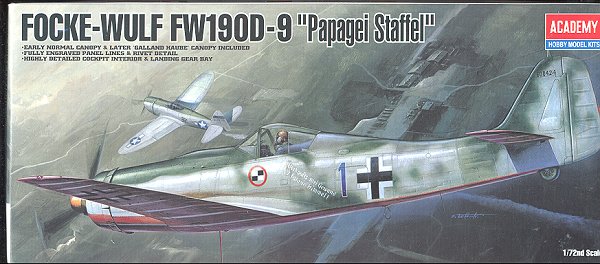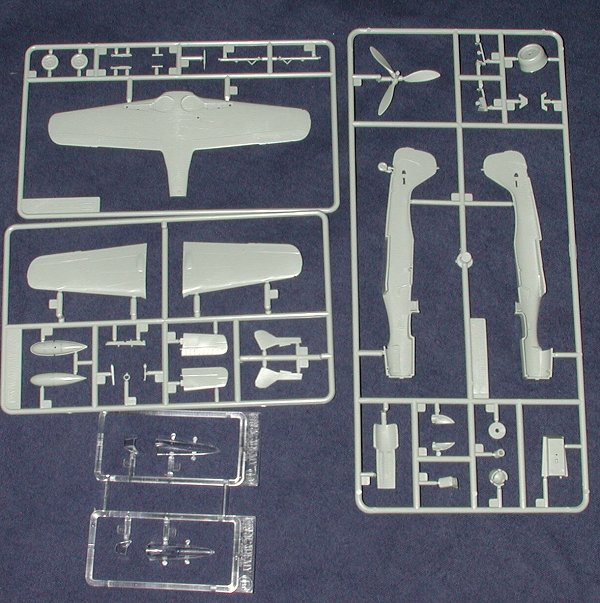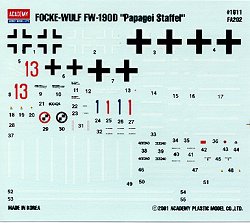
|
KIT: |
Academy 1/72 Fw-190D-9 |
|
KIT # |
1611 |
|
PRICE: |
$9.50 MSRP |
|
DECALS: |
Two aircraft |
|
REVIEWER: |
|
|
NOTES: |

|
HISTORY |
Not counting the Ta-152 series, the FW-190D-9 was probably the finest production piston-engined fighter that the Luftwaffe flew. Unfortunately for them, there were too few of them, the pilots were too inexperienced and it was just too late to make any real difference in the outcome of the war.
It was a classic example of the right airframe finally getting the right engine. All previous FW-190s had been powered by a radial BMW engine. The much more powerful liquid-cooled Junkers Jumo 213 is what turned this aircraft from adequate to sterling. This particular boxing is for an aircraft of the very colorful Papagei or Parrot staffel. So called because of the colorful red (and some say also black) underside with white stripes. This was done so that friendly anti-aircraft gunners would not shoot them down! These aircraft were used to protect Me-262s during their most vulnerable times; landing and taking off.
|
THE KIT |

Academy's kit is a pretty recent issue. Both the older Hasegawa kit and the newer Tamiya version are also a nice choice. However, the Hasegawa version has been accused of having some shape problems in the fin/rudder area, and the Tamiya one is much more expensive. Now I have not noticed the shape problem with the Hasegawa kit, but it has also been a long time since I built one and don't have a kit for comparison.
 The kit itself is in Academy's
usual grey plastic. The surface detailing is superb with the requisite engraved
panel lines. Interior consists of a tub with raised detail on the side consoles
and the instrument panel. There is also a seat and control stick but no rudder
pedals. There are two canopy options for those wanting to use aftermarket
decals. The kit markings are for a plane with the larger 'blown' canopy. The
canopy is also separate from the windscreen so that you can display the canopy
open should you wish. Other than the canopy type, there are no options other
than a drop tank which was carried by almost all 190Ds. Some were used as
fighter bombers, but you'd need some sort of photographic reference before
wanting to tackle that job.
The kit itself is in Academy's
usual grey plastic. The surface detailing is superb with the requisite engraved
panel lines. Interior consists of a tub with raised detail on the side consoles
and the instrument panel. There is also a seat and control stick but no rudder
pedals. There are two canopy options for those wanting to use aftermarket
decals. The kit markings are for a plane with the larger 'blown' canopy. The
canopy is also separate from the windscreen so that you can display the canopy
open should you wish. Other than the canopy type, there are no options other
than a drop tank which was carried by almost all 190Ds. Some were used as
fighter bombers, but you'd need some sort of photographic reference before
wanting to tackle that job.
The instructions are quite good and supply all the color information you'd need. There are two decal options for two different staffel aircraft. One is in RLM 82/83/76 over red and the other is RLM 81/832/75/76 over red. The stripes are provided as decals. The decals themselves are very gloss and should work fairly well. I'd personally paint the underside white, mask the stripes and then paint it red. White kit decals are notorious for being a bit transparent anyway and the red will only make that more evident.
|
CONCLUSIONS |
From what it seems to me, this is a kit that should build quite rapidly as there are few parts. It is the painting and decaling that will be time consuming. However, once you get it finished, it will be a real beauty. Though I didn't use it for this preview, there is an excellent reference to the Papegei staffel in the Classic Publications 'JV-44' book.
Review kit courtesy of my kit collection.
If you would like your product reviewed fairly and quickly by a site that has well over 100,000 visitors a month, please contact me or see other details in the Note to Contributors.